2013 VOLKSWAGEN GOLF GTI display
[x] Cancel search: displayPage 114 of 319
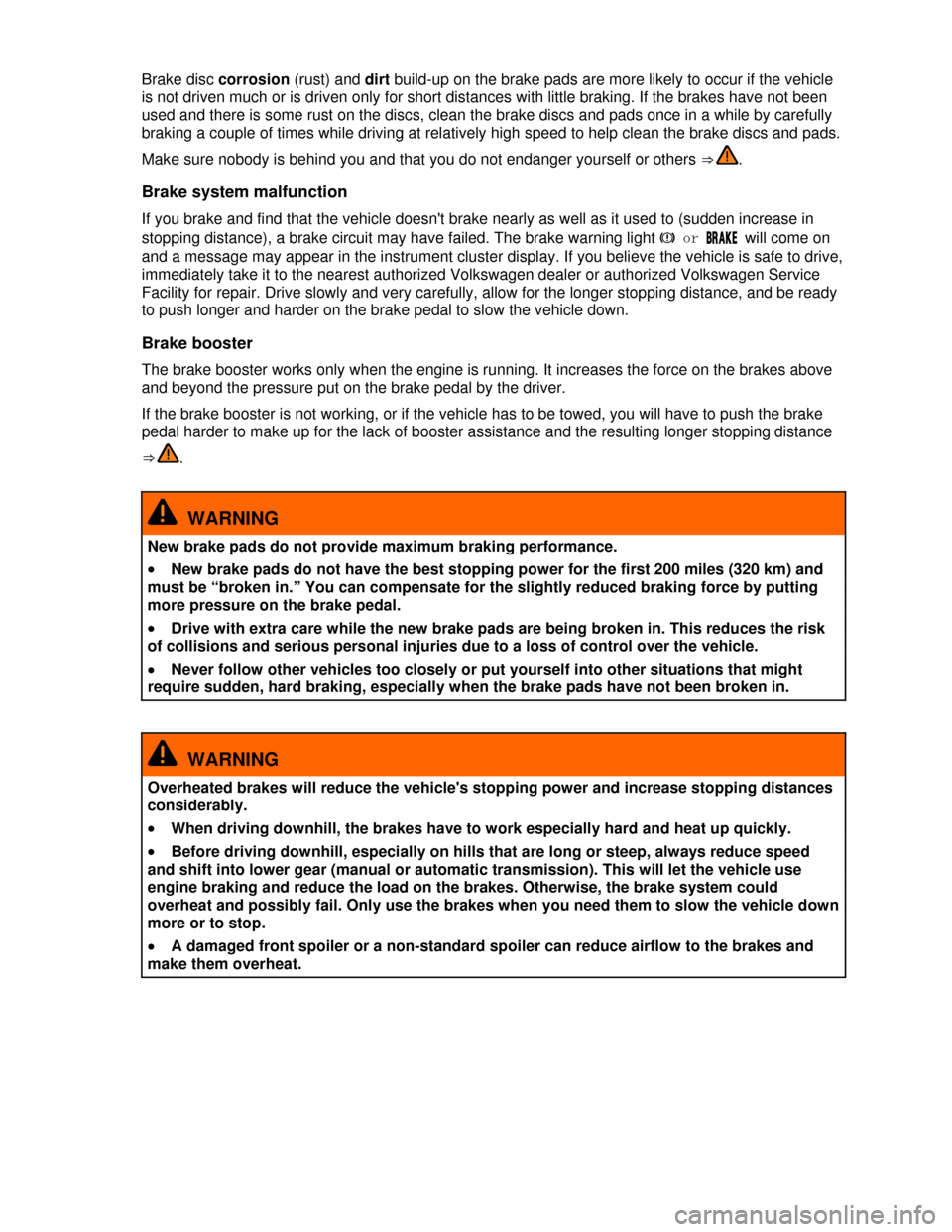
Brake disc corrosion (rust) and dirt build-up on the brake pads are more likely to occur if the vehicle
is not driven much or is driven only for short distances with little braking. If the brakes have not been
used and there is some rust on the discs, clean the brake discs and pads once in a while by carefully
braking a couple of times while driving at relatively high speed to help clean the brake discs and pads.
Make sure nobody is behind you and that you do not endanger yourself or others ⇒ .
Brake system malfunction
If you brake and find that the vehicle doesn't brake nearly as well as it used to (sudden increase in
stopping distance), a brake circuit may have failed. The brake warning light �H or �"�2�!�+�% will come on
and a message may appear in the instrument cluster display. If you believe the vehicle is safe to drive,
immediately take it to the nearest authorized Volkswagen dealer or authorized Volkswagen Service
Facility for repair. Drive slowly and very carefully, allow for the longer stopping distance, and be ready
to push longer and harder on the brake pedal to slow the vehicle down.
Brake booster
The brake booster works only when the engine is running. It increases the force on the brakes above
and beyond the pressure put on the brake pedal by the driver.
If the brake booster is not working, or if the vehicle has to be towed, you will have to push the brake
pedal harder to make up for the lack of booster assistance and the resulting longer stopping distance
⇒ .
WARNING
New brake pads do not provide maximum braking performance.
�x New brake pads do not have the best stopping power for the first 200 miles (320 km) and
must be “broken in.” You can compensate for the slightly reduced braking force by putting
more pressure on the brake pedal.
�x Drive with extra care while the new brake pads are being broken in. This reduces the risk
of collisions and serious personal injuries due to a loss of control over the vehicle.
�x Never follow other vehicles too closely or put yourself into other situations that might
require sudden, hard braking, especially when the brake pads have not been broken in.
WARNING
Overheated brakes will reduce the vehicle's stopping power and increase stopping distances
considerably.
�x When driving downhill, the brakes have to work especially hard and heat up quickly.
�x Before driving downhill, especially on hills that are long or steep, always reduce speed
and shift into lower gear (manual or automatic transmission). This will let the vehicle use
engine braking and reduce the load on the brakes. Otherwise, the brake system could
overheat and possibly fail. Only use the brakes when you need them to slow the vehicle down
more or to stop.
�x A damaged front spoiler or a non-standard spoiler can reduce airflow to the brakes and
make them overheat.
Page 127 of 319
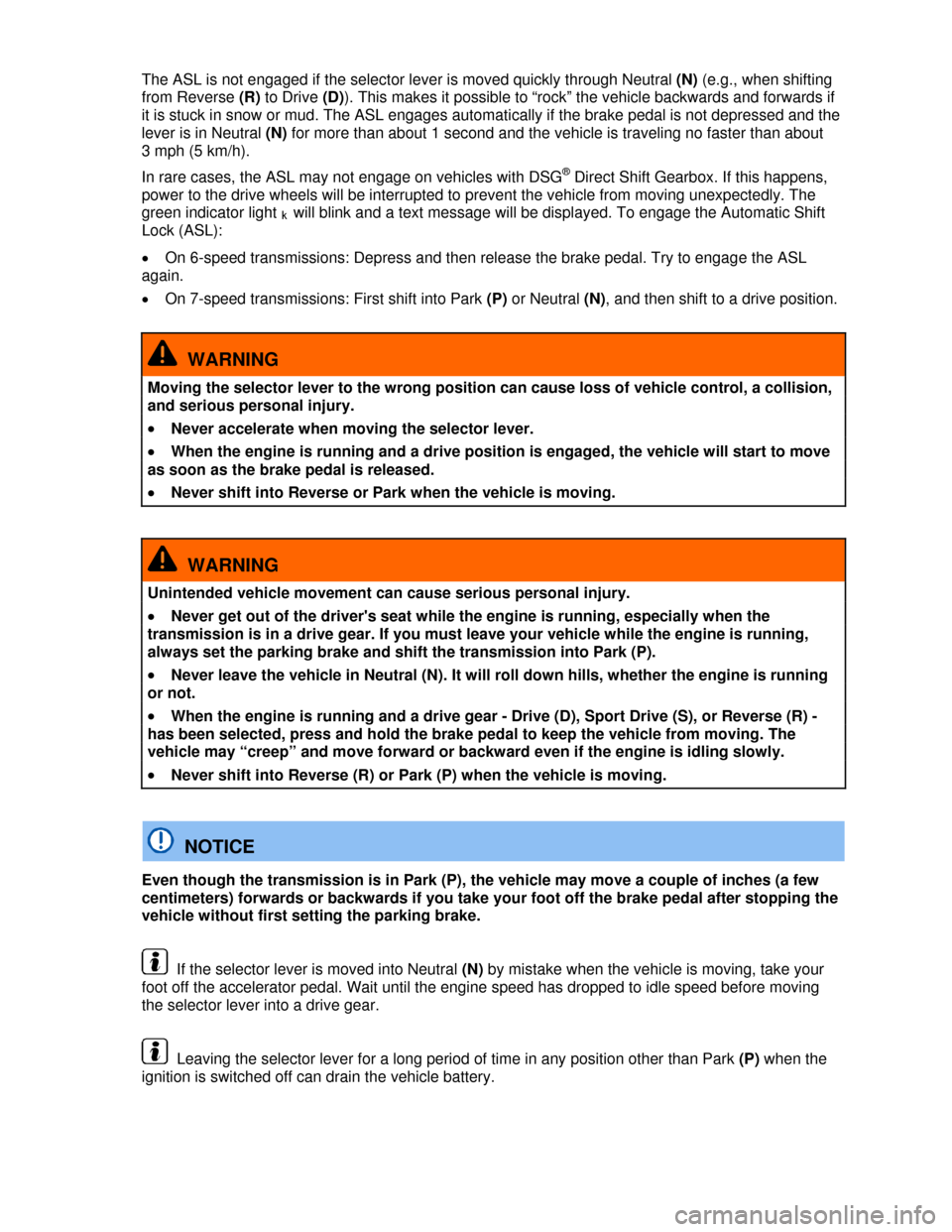
The ASL is not engaged if the selector lever is moved quickly through Neutral (N) (e.g., when shifting
from Reverse (R) to Drive (D)). This makes it possible to “rock” the vehicle backwards and forwards if
it is stuck in snow or mud. The ASL engages automatically if the brake pedal is not depressed and the
lever is in Neutral (N) for more than about 1 second and the vehicle is traveling no faster than about
3 mph (5 km/h).
In rare cases, the ASL may not engage on vehicles with DSG® Direct Shift Gearbox. If this happens,
power to the drive wheels will be interrupted to prevent the vehicle from moving unexpectedly. The
green indicator light k will blink and a text message will be displayed. To engage the Automatic Shift
Lock (ASL):
�x On 6-speed transmissions: Depress and then release the brake pedal. Try to engage the ASL
again.
�x On 7-speed transmissions: First shift into Park (P) or Neutral (N), and then shift to a drive position.
WARNING
Moving the selector lever to the wrong position can cause loss of vehicle control, a collision,
and serious personal injury.
�x Never accelerate when moving the selector lever.
�x When the engine is running and a drive position is engaged, the vehicle will start to move
as soon as the brake pedal is released.
�x Never shift into Reverse or Park when the vehicle is moving.
WARNING
Unintended vehicle movement can cause serious personal injury.
�x Never get out of the driver's seat while the engine is running, especially when the
transmission is in a drive gear. If you must leave your vehicle while the engine is running,
always set the parking brake and shift the transmission into Park (P).
�x Never leave the vehicle in Neutral (N). It will roll down hills, whether the engine is running
or not.
�x When the engine is running and a drive gear - Drive (D), Sport Drive (S), or Reverse (R) -
has been selected, press and hold the brake pedal to keep the vehicle from moving. The
vehicle may “creep” and move forward or backward even if the engine is idling slowly.
�x Never shift into Reverse (R) or Park (P) when the vehicle is moving.
NOTICE
Even though the transmission is in Park (P), the vehicle may move a couple of inches (a few
centimeters) forwards or backwards if you take your foot off the brake pedal after stopping the
vehicle without first setting the parking brake.
If the selector lever is moved into Neutral (N) by mistake when the vehicle is moving, take your
foot off the accelerator pedal. Wait until the engine speed has dropped to idle speed before moving
the selector lever into a drive gear.
Leaving the selector lever for a long period of time in any position other than Park (P) when the
ignition is switched off can drain the vehicle battery.
Page 134 of 319
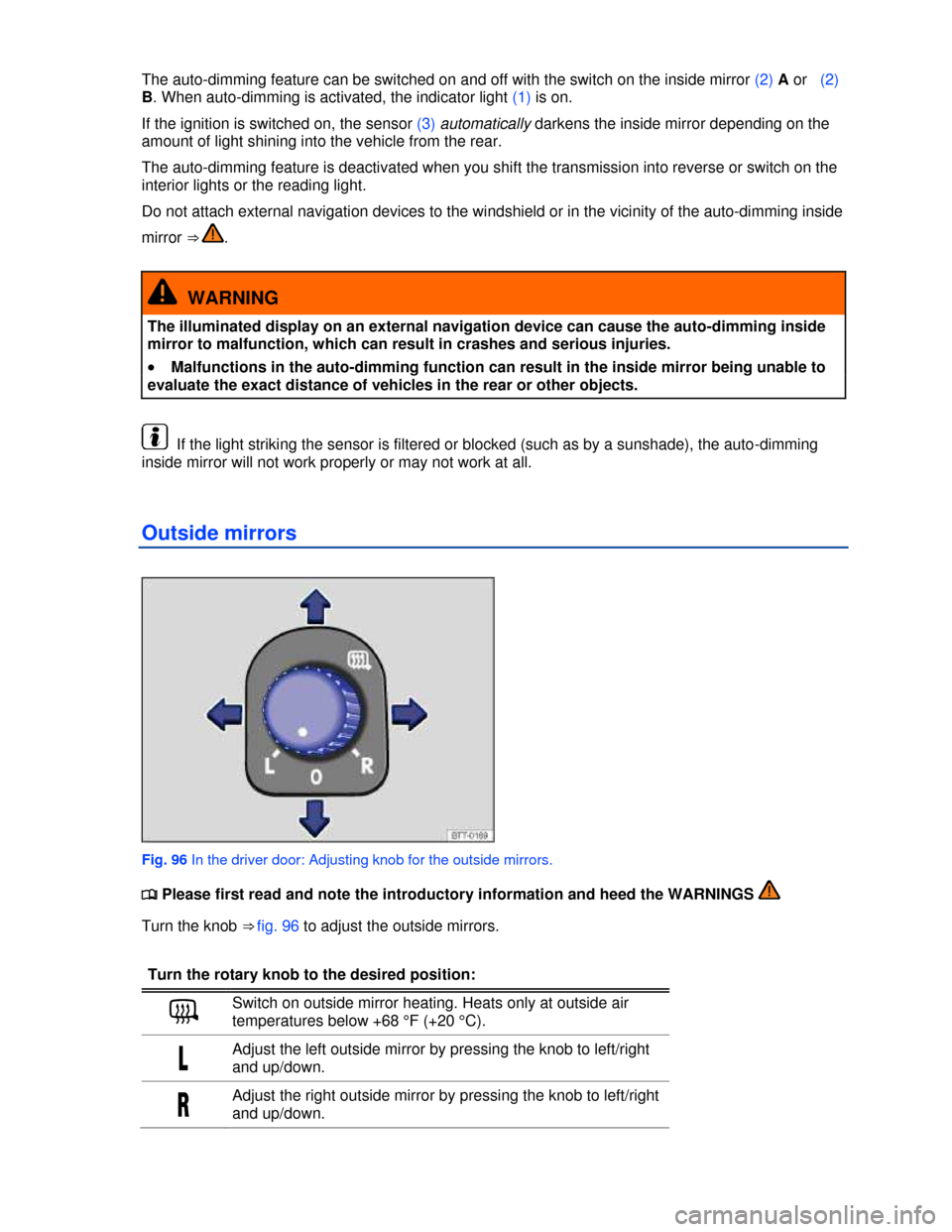
The auto-dimming feature can be switched on and off with the switch on the inside mirror (2) A or (2)
B. When auto-dimming is activated, the indicator light (1) is on.
If the ignition is switched on, the sensor (3) automatically darkens the inside mirror depending on the
amount of light shining into the vehicle from the rear.
The auto-dimming feature is deactivated when you shift the transmission into reverse or switch on the
interior lights or the reading light.
Do not attach external navigation devices to the windshield or in the vicinity of the auto-dimming inside
mirror ⇒ .
WARNING
The illuminated display on an external navigation device can cause the auto-dimming inside
mirror to malfunction, which can result in crashes and serious injuries.
�x Malfunctions in the auto-dimming function can result in the inside mirror being unable to
evaluate the exact distance of vehicles in the rear or other objects.
If the light striking the sensor is filtered or blocked (such as by a sunshade), the auto-dimming
inside mirror will not work properly or may not work at all.
Outside mirrors
Fig. 96 In the driver door: Adjusting knob for the outside mirrors.
�
Page 177 of 319
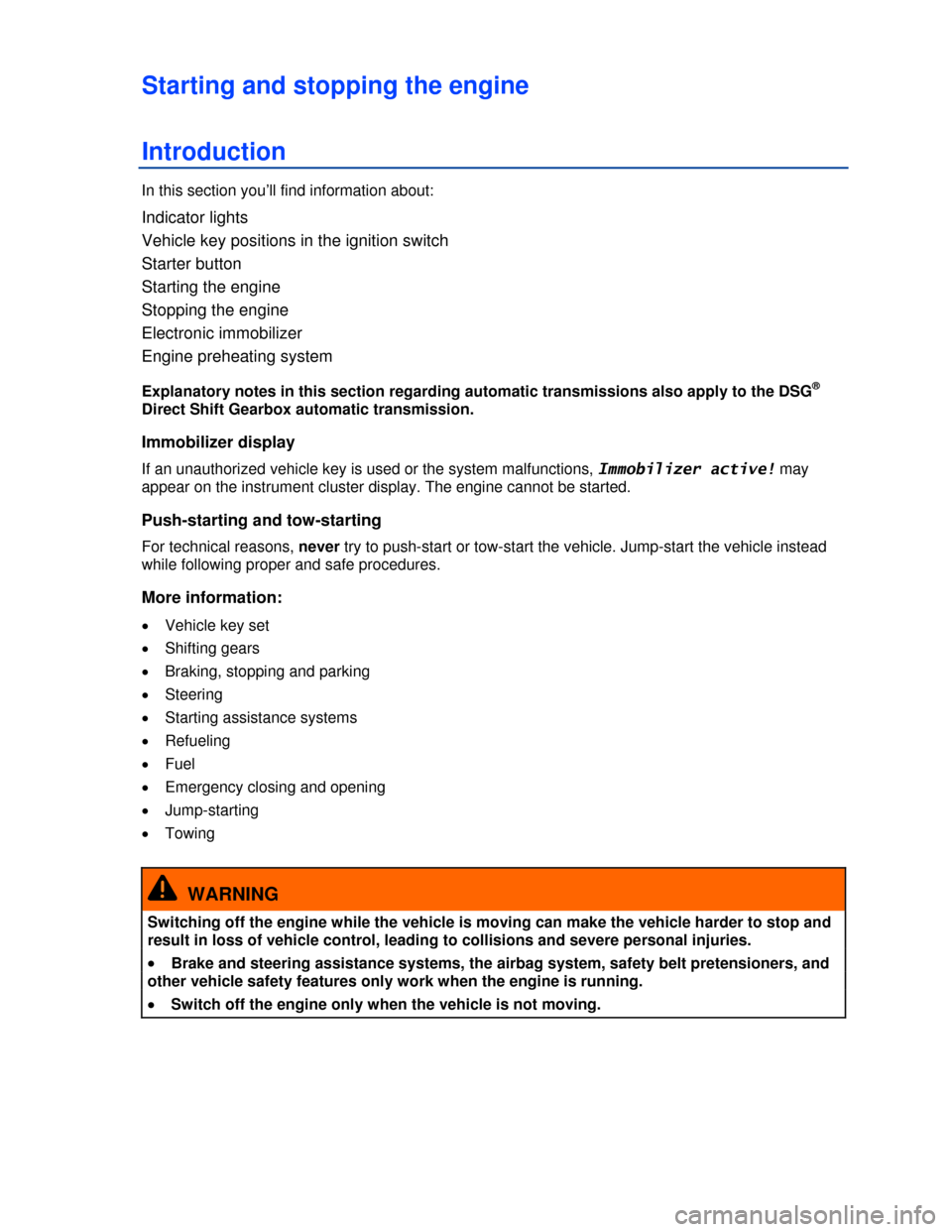
Starting and stopping the engine
Introduction
In this section you’ll find information about:
Indicator lights
Vehicle key positions in the ignition switch
Starter button
Starting the engine
Stopping the engine
Electronic immobilizer
Engine preheating system
Explanatory notes in this section regarding automatic transmissions also apply to the DSG®
Direct Shift Gearbox automatic transmission.
Immobilizer display
If an unauthorized vehicle key is used or the system malfunctions, Immobilizer active! may
appear on the instrument cluster display. The engine cannot be started.
Push-starting and tow-starting
For technical reasons, never try to push-start or tow-start the vehicle. Jump-start the vehicle instead
while following proper and safe procedures.
More information:
�x Vehicle key set
�x Shifting gears
�x Braking, stopping and parking
�x Steering
�x Starting assistance systems
�x Refueling
�x Fuel
�x Emergency closing and opening
�x Jump-starting
�x Towing
WARNING
Switching off the engine while the vehicle is moving can make the vehicle harder to stop and
result in loss of vehicle control, leading to collisions and severe personal injuries.
�x Brake and steering assistance systems, the airbag system, safety belt pretensioners, and
other vehicle safety features only work when the engine is running.
�x Switch off the engine only when the vehicle is not moving.
Page 185 of 319
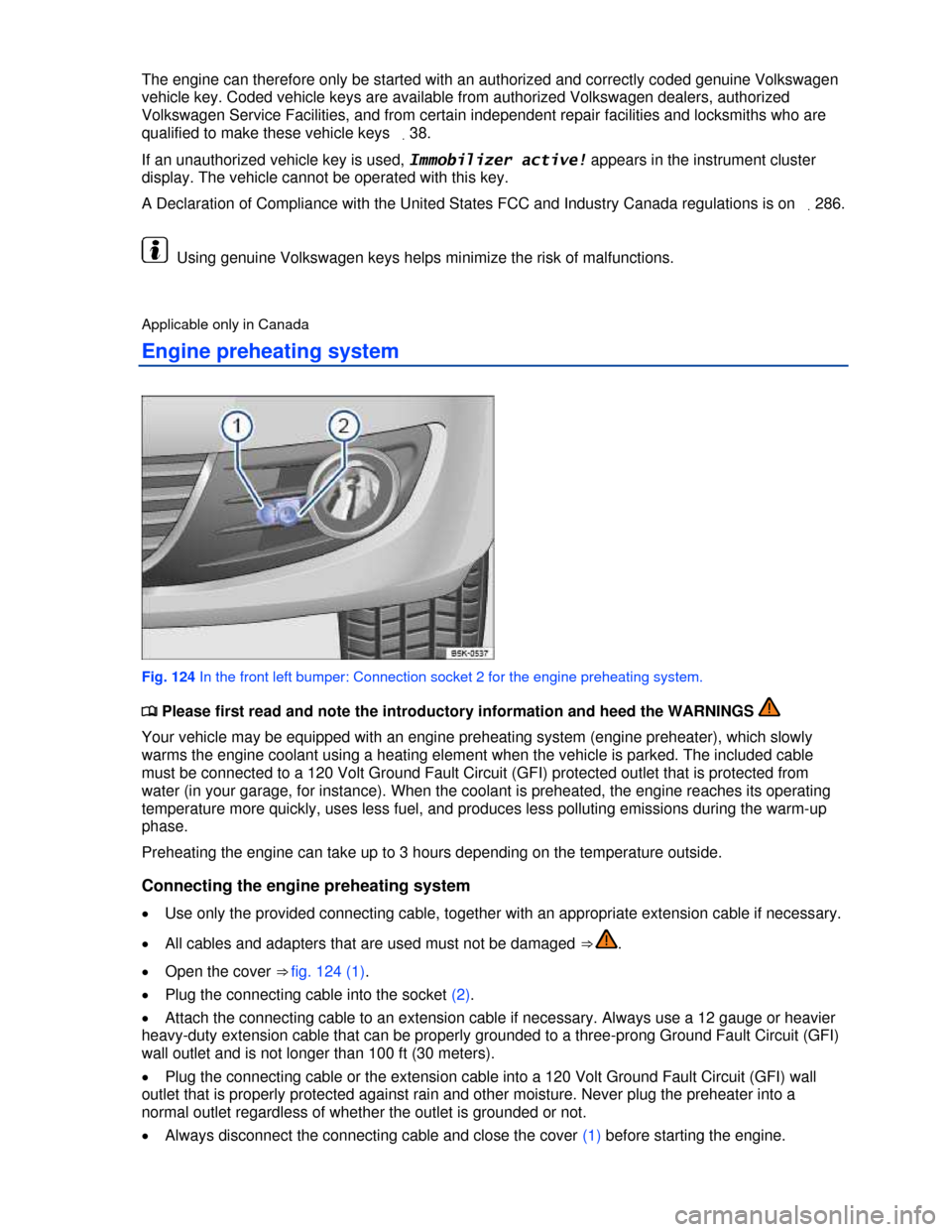
The engine can therefore only be started with an authorized and correctly coded genuine Volkswagen
vehicle key. Coded vehicle keys are available from authorized Volkswagen dealers, authorized
Volkswagen Service Facilities, and from certain independent repair facilities and locksmiths who are
qualified to make these vehicle keys .38.
If an unauthorized vehicle key is used, Immobilizer active! appears in the instrument cluster
display. The vehicle cannot be operated with this key.
A Declaration of Compliance with the United States FCC and Industry Canada regulations is on .286.
Using genuine Volkswagen keys helps minimize the risk of malfunctions.
Applicable only in Canada
Engine preheating system
Fig. 124 In the front left bumper: Connection socket 2 for the engine preheating system.
�
Page 196 of 319
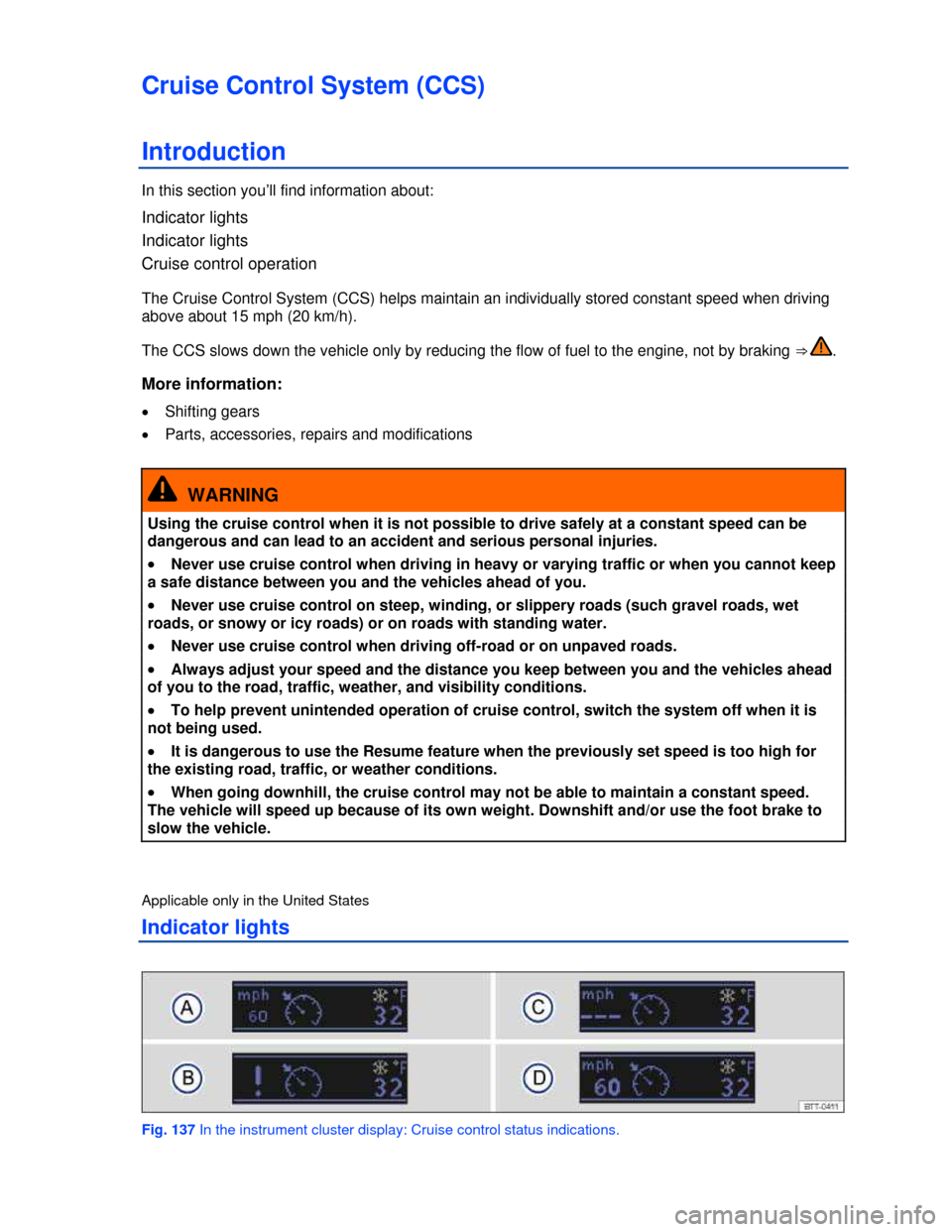
Cruise Control System (CCS)
Introduction
In this section you’ll find information about:
Indicator lights
Indicator lights
Cruise control operation
The Cruise Control System (CCS) helps maintain an individually stored constant speed when driving
above about 15 mph (20 km/h).
The CCS slows down the vehicle only by reducing the flow of fuel to the engine, not by braking ⇒ .
More information:
�x Shifting gears
�x Parts, accessories, repairs and modifications
WARNING
Using the cruise control when it is not possible to drive safely at a constant speed can be
dangerous and can lead to an accident and serious personal injuries.
�x Never use cruise control when driving in heavy or varying traffic or when you cannot keep
a safe distance between you and the vehicles ahead of you.
�x Never use cruise control on steep, winding, or slippery roads (such gravel roads, wet
roads, or snowy or icy roads) or on roads with standing water.
�x Never use cruise control when driving off-road or on unpaved roads.
�x Always adjust your speed and the distance you keep between you and the vehicles ahead
of you to the road, traffic, weather, and visibility conditions.
�x To help prevent unintended operation of cruise control, switch the system off when it is
not being used.
�x It is dangerous to use the Resume feature when the previously set speed is too high for
the existing road, traffic, or weather conditions.
�x When going downhill, the cruise control may not be able to maintain a constant speed.
The vehicle will speed up because of its own weight. Downshift and/or use the foot brake to
slow the vehicle.
Applicable only in the United States
Indicator lights
Fig. 137 In the instrument cluster display: Cruise control status indications.
Page 198 of 319
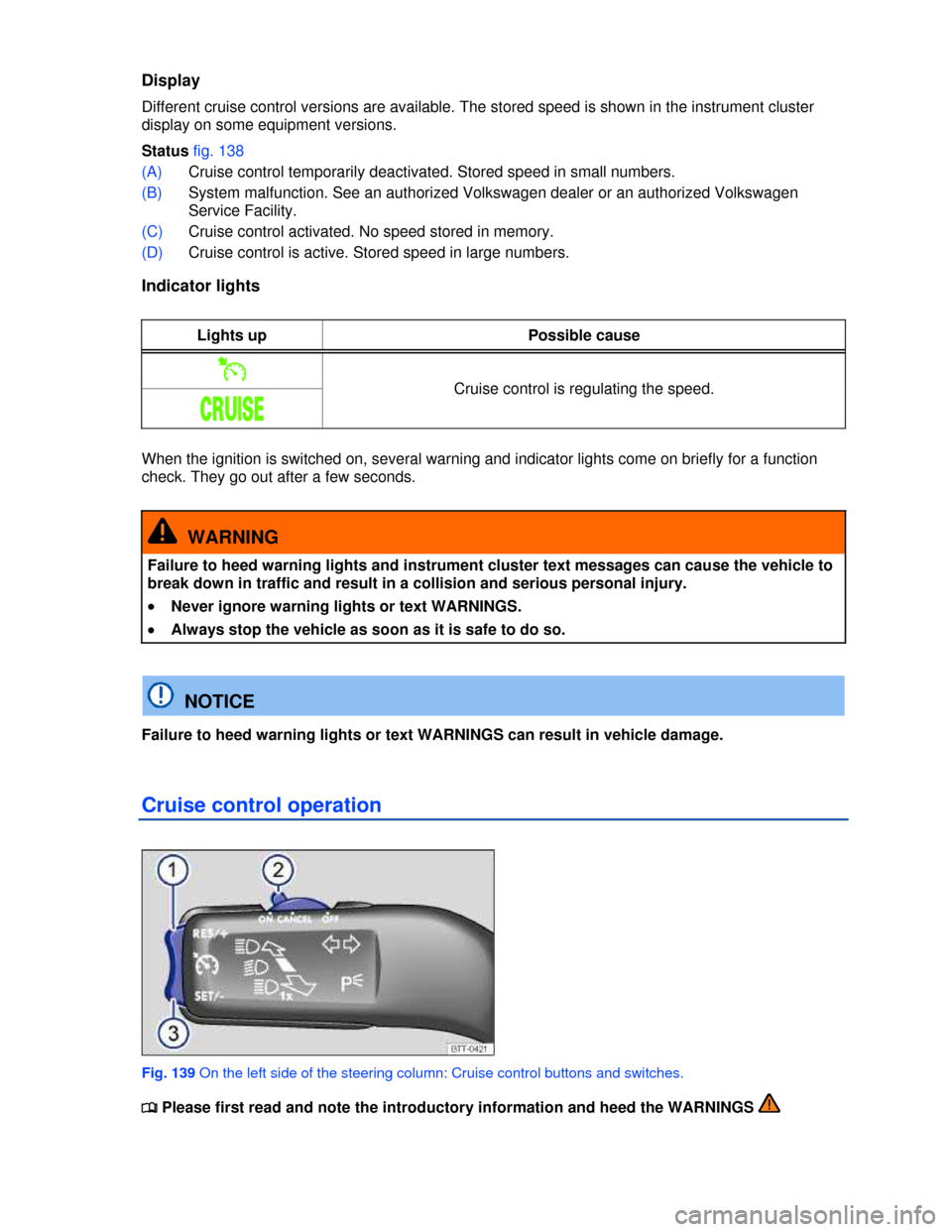
Display
Different cruise control versions are available. The stored speed is shown in the instrument cluster
display on some equipment versions.
Status fig. 138
(A) Cruise control temporarily deactivated. Stored speed in small numbers.
(B) System malfunction. See an authorized Volkswagen dealer or an authorized Volkswagen
Service Facility.
(C) Cruise control activated. No speed stored in memory.
(D) Cruise control is active. Stored speed in large numbers.
Indicator lights
Lights up Possible cause
�% Cruise control is regulating the speed.
�#�2�5�)�3�%
When the ignition is switched on, several warning and indicator lights come on briefly for a function
check. They go out after a few seconds.
WARNING
Failure to heed warning lights and instrument cluster text messages can cause the vehicle to
break down in traffic and result in a collision and serious personal injury.
�x Never ignore warning lights or text WARNINGS.
�x Always stop the vehicle as soon as it is safe to do so.
NOTICE
Failure to heed warning lights or text WARNINGS can result in vehicle damage.
Cruise control operation
Fig. 139 On the left side of the steering column: Cruise control buttons and switches.
�
Page 205 of 319

Applicable only in the United States
Heating and air conditioning
Introduction
In this section you’ll find information about:
Controls
Controls
Air conditioner operation
Air vents
Air recirculation
Air recirculation
Manual air conditioning (AC) and Climatronic
Your vehicle is equipped either with a Manual AC climate control system or a Climatronic
climate control system.
On vehicles with Climatronic climate control, Climatronic information appears in the Climatronic display
and/or on the screen of the factory-installed Radio system or Radio & Navigation system.
The temperature units (Fahrenheit or Celsius) in the factory-installed Radio system or Radio &
Navigation system screen can be changed in the Settings menu in the Premium instrument cluster
display in appropriately equipped vehicles.
The dust and pollen filter
The dust and pollen filter with an activated carbon insert reduces the entry of pollutants into the
passenger compartment.
The dust and pollen filter must be replaced at the intervals recommended in ⇒ Booklet Warranty and
Maintenance so that the air conditioner can work properly.
If the effectiveness of the filter decreases prematurely due to operating the vehicle where the outside
air is heavily polluted, the dust and pollen filter should be replaced more frequently than indicated.
More information:
�x Exterior views
�x Passenger compartment
�x Volkswagen Information System
�x Seat functions
�x Windshield wiper and washer
�x Starting and stopping the engine
�x Exterior care and cleaning